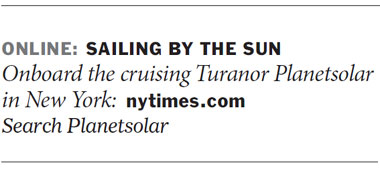Solar boat put to work for researchers
Updated: 2013-07-07 08:32
By Henry Fountain(The New York Times)
|
|||||||
|
A 30-meter catamaran covered with solar panels stopped in New York on a research cruise. Jabin Botsford / The New York Times |

Last year, after it became the first solar-powered boat to circumnavigate the globe, the Turanor Planetsolar could have taken its 510 square meters of photovoltaic cells and seven metric tons of lithium-ion batteries and sailed off into the sunset.
Instead, the boat will cruise the Gulf Stream studying the role of atmospheric aerosols and phytoplankton in regulating climate, under the direction of Martin Beniston, a climatologist at the University of Geneva.
The research cruise began in Miami and will stop in Newfoundland and Iceland as it tracks the northeasterly current. The voyage is expected to end in Bergen, Norway, in August.
In mid-June, the boat stopped in New York City for a few days. The 30-meter, $17 million catamaran was dreamed up by a Swiss eco-adventurer and bankrolled by a German businessman. Completely powered by the sun - the high-efficiency solar cells charge the batteries that power electric motors connected to the craft's twin propellers - it produces no emissions of carbon dioxide or other gases that could contaminate air samples. And the boat has no problem going slowly, if necessary, as it samples the water - its average speed is a sluggish five knots.
Research equipment added includes a "ferrybox" that constantly records the temperature, salinity and other characteristics of the water. It also has a "biobox," developed by the university's applied physics department, which uses a laser to analyze the number and type of aerosols in air samples.
The problem of ocean-generated aerosols - solid or liquid particles in the atmosphere that can have an impact through cloud formation, reflection of sunlight and other processes - is a relatively new one in climate science, Dr. Beniston said. "We suppose that the ocean must be a fairly large contributor" of aerosols through the action of waves and wind, he said. "Their exact role is still open to question."
Dr. Beniston's plan is to examine smaller-scale structures in the Gulf Stream, including eddies, swirling offshoots of the current. Eddies tend to have more upwelling of colder, deeper water than the Gulf Stream itself, so one goal is to see whether different water conditions produce different aerosols. Bastiaan Ibelings, a microbial ecologist at the University of Geneva, wants to see whether the conditions in eddies result in more or less biological diversity than elsewhere.
The boat, which ended its 19-month, 59,500-kilometer circumnavigation in May 2012, is "an ambassador for solar energy," said Gerard d'Aboville, its current captain.
Planetsolar poses some unique challenges. In addition to wind, waves and current, Mr. d'Aboville must constantly consider the amount of sunlight hitting the photovoltaic cells, keeping the batteries as charged as possible. (They can power the boat for about 72 hours when fully charged.)
He said: "I have this new parameter of the sun, and it makes life interesting."
The New York Times
(China Daily 07/07/2013 page9)
